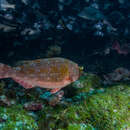Diagnostic Description
provided by Fishbase
TP individuals readily separated from S. rubripinne by the presence of a distinctive bright-yellow area on the pectoral -fin axil, blackish caudal fin margins, yellowish dorsal and anal fins, and general body color which is grayish-white in S. axillare and blue-green in S. rubripinne. Initial phase individuals of S. axillare are brownish-gray with a yellow stain on the flanks and different from S. rubripinne by the absence of a bright- yellow area on the caudal peduncle and caudal fin. Head profile more rounded S. axillare (Ref. 40827).
- Recorder
- Estelita Emily Capuli
Trophic Strategy
provided by Fishbase
A herbivore (Ref. 33499, 126840), cleaned by Elacatinus figaro observed off the coast of São Paulo, southeastern Brazil (Ref. 40102) and by Pomacanthus paru observed at the reefs of the Abrolhos Archipelago, off eastern Brazil (Ref. 40094).
- Recorder
- Estelita Emily Capuli
Biology
provided by Fishbase
Maximum depth from Ref. 126840. Occurs in oceanic islands, dwelling in coral, algal and rocky reefs and on algal beds (Ref. 40827). An herbivore (Ref. 33499), cleaned by Elacatinus figaro observed off the coast of São Paulo, southeastern Brazil (Ref. 40102) and by Pomacanthus paru observed at the reefs of the Abrolhos Archipelago, off eastern Brazil (Ref. 40094).
- Recorder
- Estelita Emily Capuli
Comprehensive Description
provided by Smithsonian Contributions to Zoology
Sparisoma axillare (Steindachner)
Scarus (Scarus) axillaris Steindachner, 1878, p. 6, pl. 3: fig. 1.
Sparisoma axillare.—Schultz, 1958, p. 117, pl. 23A.—Randall, 1963, pp. 234–235, p. 3D.
Scarus rubripinnis Cuvier and Valenciennes, 1839, p. 199.
Sparisoma rubripinne.—Schultz, 1958, p. 118, pl. 23C, D.—Bauchot and Blanc, 1961, p. 61 [St. Thomas Island, eastern Atlantic].—Caldwell, 1963, p. 7 [Costa Rica].—Cervigon, 1966, p. 621, fig. 266.—Stark and Davis, 1966, p. 339 [night habits].
Scarus virens Cuvier and Valenciennes, 1839, p. 203.—Bauchot and Guibè, 1960, p. 299 [syntypes nos. 1768 and 8228 in Paris Museum].
Characterized by having a convex interorbital space, multifid cirri distally on flap of anterior nostril; membraneous tip of dorsal spines with a few cirri; on large males numerous small canine teeth variously placed externally on upper dental plate, those at median suture may overlap.
Dr. Randall (1963, pp. 234–235) gives the following color description:
Adult males (axillare) are characterized by dull blue-green coloration dorsally, lighter ventrally, with centers of scales purplish shading through olive to blue-green on edges, unscaled part of head olive; upper lip and chin turquoise, throat white; caudal fin olive, lobes purplish blue, with an orange crescent distally; dorsal and anal fins yellowish to orange brown; black spot on dorsal half of pectoral base; teeth light blue.
Immature and females (rubripinne) light grayish brown, nearly white ventrally; edges of scales dark; chin with 2 dark crossbars; caudal peduncle and caudal fin yellow; dorsal yellow; anal and pelvic fins red.
Dr. Randall (loc. cit.) has shown that S. rubripinne is the female and immature of S. axillare.
RANGE.—Eastern, central, and western Atlantic Ocean.
Sparisoma chrysopterum (Bloch and Schneider)
Scarus chrysopterum Bloch and Schneider, 1801, p. 286, pl. 57.
Sparisoma chrysopterum.—Schultz, 1958, p. 120, pl. 4B, 23B.—Winn and Bardach, 1959, pp. 296–298.—Cervigon, 1966, p. 625, fig. 269.—Stark and Davis, 1966, p. 339 [night habits].
Scarus flavescens Bloch and Schneider, 1801, p. 290.—Randall, 1963, pp. 235–237, fig. 4.
See Schultz (1958, p. 120) for other synonyms.
Characterized by having a slightly concave to flattish (slightly convex in young) interorbital space; pectoral base with black spot dorsally; anterior nostril with ribbon-like dermal flap bearing 0 to 4 cirri; membranes at rear of tips of dorsal spines without or with 1 to 2 feeble cirri (tip of dorsal spine usually ending in cirrus); caudal fin strongly forked in adults; several canine teeth may occur on sides of dental plates of upper jaw, some of which may interlock at median suture.
Dr. Randall (1963, pp. 235–237) has shown that S. flavescens Bloch and Schneider is a synonym of S. chrysopterum. He gave the following description of coloration of males and females:
Centers of scales (males) purplish blue, edges olivaceous green on upper part of body, abruptly turquoise on lower third of body; area under pectoral blue, becoming turquoise ventrally; with a streak of yellowish green extending forward from blue-green part of body at level of anus; caudal lobes green, outer edges black, middle pink, basally orange next green, distal margin white.
Coloration (females) olivaceous tan dorsally, basal part of scales brownish red, and sides and ventrally paler, basal part of scales bright red, rear half yellowish; 2 broad red cross bars on chin; head with numerous light spots on snout, and interorbital space, fewer light spots on scaled part of head; median fins mottled brownish red; lower half of pectoral base, axillary region, dorsally and forward to edge of gill opening just above pectoral base bright red.
RANGE.—Central and western Atlantic Ocean.
- bibliographic citation
- Schultz, Leonard P. 1969. "The taxonomic status of the controversial genera and species of parrotfishes with a descriptive list (family Scardiae)." Smithsonian Contributions to Zoology. 1-49. https://doi.org/10.5479/si.00810282.17

